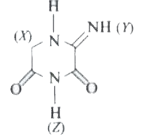(X),(Y),(Z) are elements in third short period. Oxide of (X) is ionic, (Y) is amphoteric and (Z) is a giant molecule. (X),(Y) and (Z) will have atomic number in the order :
(X)<(Y)<(Z)
(Z)<(Y)<(X)
(X)<(Z)<(Y)
(Y)<(X)<(Z)
The correct Answer is:A

Hence, the atomic number of (Z)>(Y)>(X).
Topper's Solved these Questions
- BOOK - CENGAGE CHEMISTRY ENGLISHCHAPTER - PERIODIC CLASSIFICATION OF ELEMENTS AND GENERAL INORGANIC CHEMISTRYEXERCISE - Ex 1.313videos
PERIODIC CLASSIFICATION OF ELEMENTS AND GENERAL INORGANIC CHEMISTRY
- BOOK - CENGAGE CHEMISTRY ENGLISHCHAPTER - PERIODIC CLASSIFICATION OF ELEMENTS AND GENERAL INORGANIC CHEMISTRYEXERCISE - Ex 1.3 (Objective)8videos
PERIODIC CLASSIFICATION OF ELEMENTS AND GENERAL INORGANIC CHEMISTRY
- BOOK - CENGAGE CHEMISTRY ENGLISHCHAPTER - PERIODIC CLASSIFICATION OF ELEMENTS AND GENERAL INORGANIC CHEMISTRYEXERCISE - Ex 1.21videos
PERIODIC CLASSIFICATION OF ELEMENTS AND GENERAL INORGANIC CHEMISTRY
- BOOK - CENGAGE CHEMISTRY ENGLISHCHAPTER - P-BLOCK GROUP 14 - CARBON FAMILYEXERCISE - Exercises Archives (Subjective)9videos
P-BLOCK GROUP 14 - CARBON FAMILY
- BOOK - CENGAGE CHEMISTRY ENGLISHCHAPTER - PURIFICATION OF ORGANIC COMPOUNDS AND QUALITATIVE AND QUANTITATIVE ANALYSISEXERCISE - Assertion Reasoning Type5videos
PURIFICATION OF ORGANIC COMPOUNDS AND QUALITATIVE AND QUANTITATIVE ANALYSIS
Similar Questions
Three elements of 3rd period x,y,z such that the oxide of X is acidic, y is amphoteric and z id basic, the order of atomic no of three elements isL
View SolutionThree elements X, Y and Z are in the 3rd periodic table. The oxides of X, Y and Z, respectively, are basic, amphoteric and acidic, The correct order of the atomic numbers of X, Y and Z is :
View Solution
Knowledge Check
- Question 1 - Select One
(a),(b) and (c) are elements in the second short period. Oxide of (a) is ionic, that of (b) is amphoteric and of (c) of gaint molecule. (a),(b) and (c) have atomic number in the order-
A(A)lt(B)lt(C)B(C)lt(B)lt(A)C(A)lt(B)lt(B)D(B)lt(A)lt(C) - Question 2 - Select One
 The correct basicity order of atoms X, Y and Z is :AX>Y>ZBZ>Y>XCZ>X>YDY>X>Z
The correct basicity order of atoms X, Y and Z is :AX>Y>ZBZ>Y>XCZ>X>YDY>X>Z - Question 3 - Select One
If there elements X, Y & Z crystallize in cubic solid latice with X atoms at corners, Y atoms at cube centre & Z-atoms at the edges, then the formula of the compound is
AXYZBXYZ2CXYZ3DX2Y2Z
Three elements of Dobereiner.s triad are X, Y & Z. If the atomic mass of X is 7 and Z is 39,Calculate the atomic mass of Y.
View SolutionA compound contains atoms X, Y and Z. The oxidation number of X is +3, Y is +5 and Z is −2. The possible formula of the compound is
View SolutionIf there elements X, Y & Z crystallize in cubic solid latice with X atoms at corners, Y atoms at cube centre & Z-atoms at the edges, then the formula of the compound is
View SolutionTwo radio active nuclei X and Y decay into stable nucleus Z
X→Z+2α+β−
Y→Z+α+2β+
if Z1 and Z2 are atomic numbers of X and Y thenView SolutionA compound contains atoms X,Y and Z. the oxidation number of X is +2, of Y is +5 and of Z is −2. The possible formula of the compound is
View Solution
